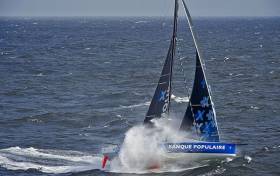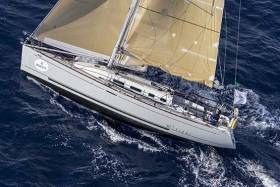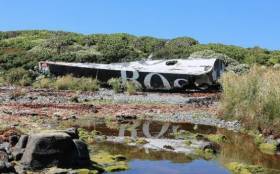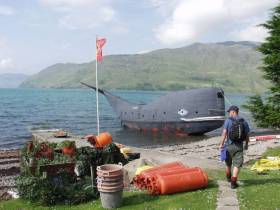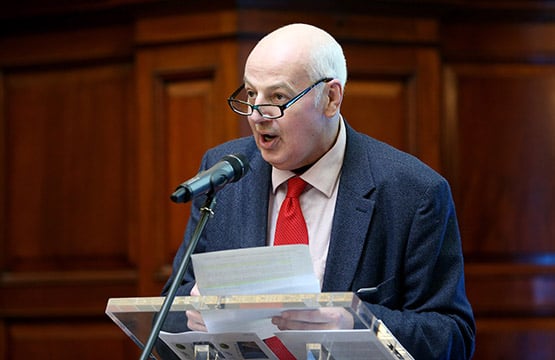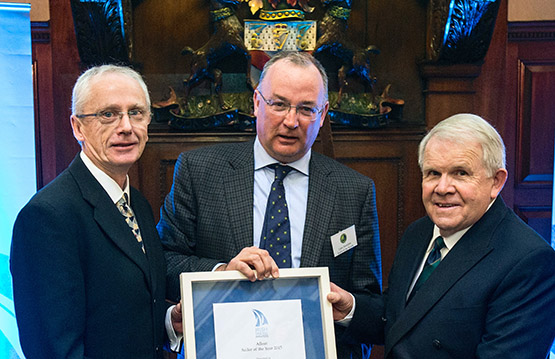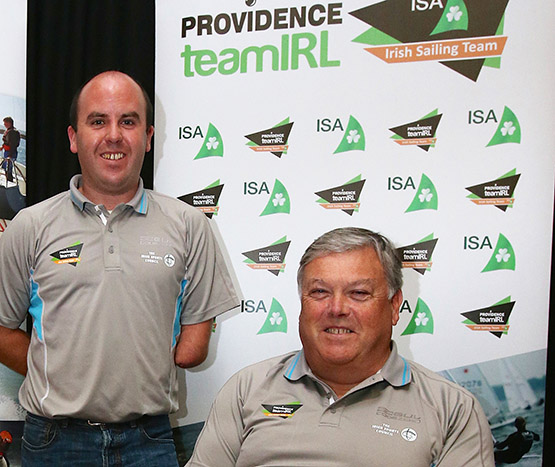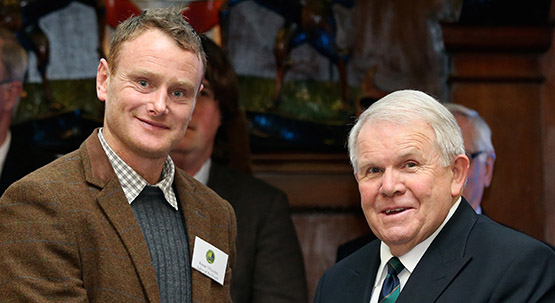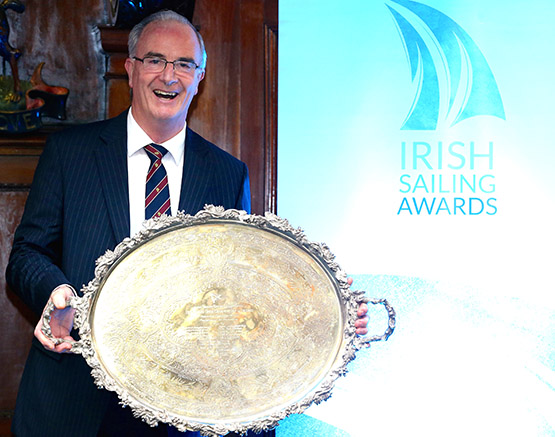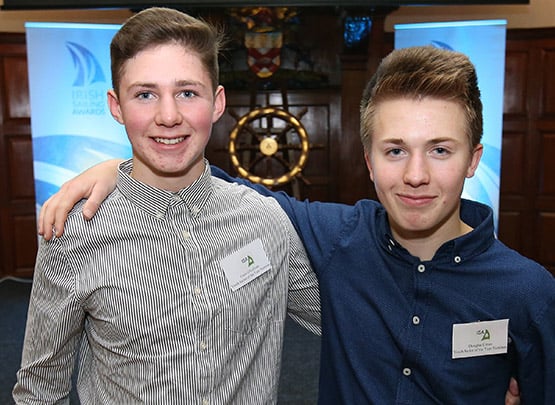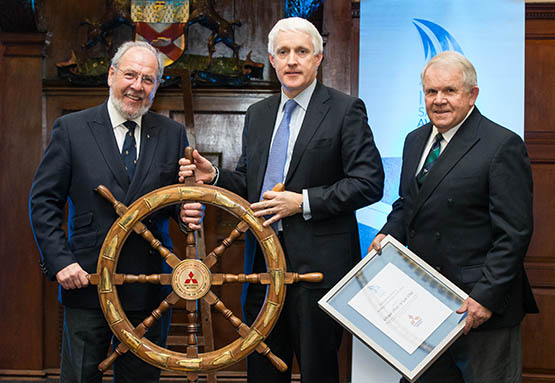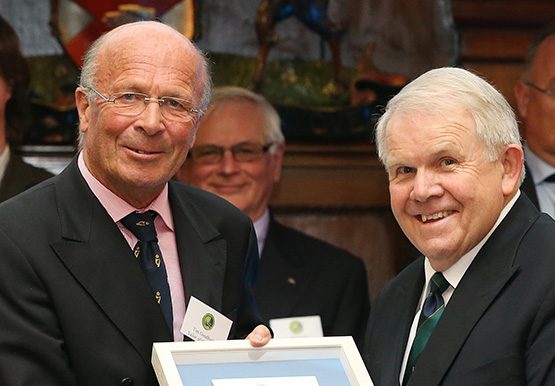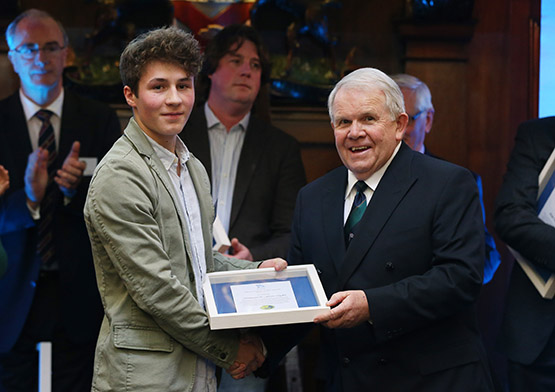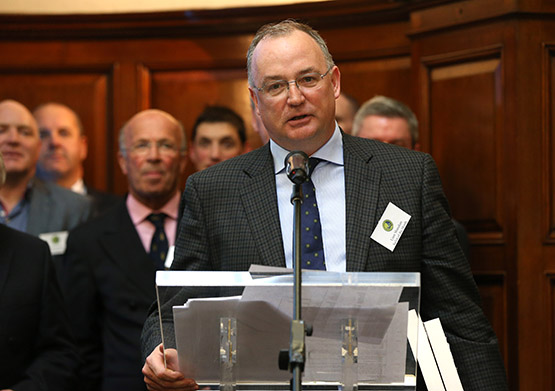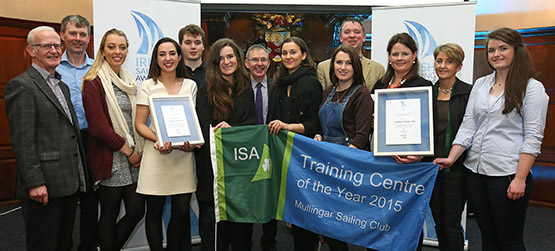Displaying items by tag: Offshore
ISORA Boats Prepare for Race to Pwllheli
The next race in the AveryCrest ISORA 2016 series is the race from Dun Laoghaire to Pwllheli this Saturday.
The race is also the feeder race for the Spinlock IRC Welsh National Championships in Pwllheli from August 12 to 14th. The 80 miler starts at 0800hrs from Dun Laoghaire harbour.
British sailor Richard Tolkien, one of the competitors in The Transat bakerly transatlantic race from Plymouth to New York, abandoned his yacht and boarded the Cargo Ship ANTON TOPIC at 21:40 GMT today, (13 May).
At 19:45, Race Control received a 'demand for assistance' from Richard Tolkien, the skipper of the IMOCA 60, 44, at a position approximately 880 nautical miles west, southwest of Horta in the Azores.
Tolkien reported that he had been struggling with some major technical issues on his boat, including damage to the inner forestay. While he was on the foredeck trying to clear the sail, which was entangled in the rig, Tolkien was hit by one of the sails, sustaining an injury to his head.
After assessment by satellite phone with his shore crew, and with the Race Director and Race Doctor, and on liaising with the MRCC (Maritime Rescue Coordination Centre), a VHF call was made to the cargo ship ANTON TOPIC, which was in the vicinity of Tolkien’s position. The decision was taken to abandon ship, on account of Tolkien’s injury and the daylight fading.
At 21:40 GMT, after an expert approach, the crew of the ANTON TOPIC were able to execute the safe transfer of Tolkien from his yacht to the ship. The ANTON TOPIC is heading to Philadelphia (USA), with an estimated time of arrival of the 18 May.
Tolkien relives his mid-Atlantic rescue - update at 1600 Sat
The British sailor Richard Tolkien today spoke about his dramatic rescue in the mid-Atlantic when he was picked up by a cargo ship after deciding to abandon his IMOCA 60, 44, in The Transat bakerly.
Tolkien, 61, from Lymington in Hampshire on the English south coast, was picked up by the cargo ship Anton Topic at a position about 880 nautical miles west of Horta in the Azores.
He had been sailing in last place in the IMOCA fleet in an old Finot-design from 1998 that was originally called Sodebo and sailed by Frenchman Thomas Coville. Tolkien took the difficult decision to abandon the boat - now called 44 after the UK dialing code - on Friday night and then made a perilous, but successful, transfer to the ship.
“I had had a sustained period of bad weather…and the wind had started to go down from 40 knots to 30,” he said on the satellite phone from the bridge of the Anton Topic this morning as it made its way towards Philadelphia. “I thought there was no trouble ahead and I was down below, looking forward to calmer conditions, when there was a large bang.
“The fitting holding the staysail stay to the deck had ruptured. By the time I got on deck the sail was flailing around. I turned the boat downwind and spent the next two hours trying to sort out the mess – it is very difficult on a boat of that size.
“I was hit in the face and then later again by a glancing blow to the side of the face by the furling drum at the bottom of the stay. On the second occasion there was a lot of blood on the deck and I went down into the cabin and realised I needed to call for assistance.
“I used the AIS (Automatic Identification System) to call up the nearest ship and the Anton Topic and its captain and crew were not too far away and came towards me and manoeuvred their ship alongside me. It was not easy at all and then I had to climb up the pilot ladder at the side of the ship and I only just made it, so it was very difficult.
“I had to leave the boat which has a tracker on it – not an easy situation - and I hope to rescue the boat. It was just a glancing blow – but if it had been a bit more full-on, then the outcome could have been very different,” Tolkien concluded.
When he got on board the Anton Topic he was treated by the ship’s medic who applied four stitches to his head wound. After a few hours sleep on board, Tolkien said he was happy that all his faculties were intact. “Apart from being tired and bit shocked, I’m OK," he said.
Tolkien set sail from Plymouth bound for New York with 24 other solo skippers on The Transat bakerly on May 2nd. A former civil servant and corporate financier, Tolkien is an experienced amateur ocean racer. He completed this race in 1992, finishing 6th in the monohull division after 17 days. In 2000 he entered the Vendée Globe solo round-the-world race but had to retire halfway down the Atlantic with sail damage. In 2010 he finished 33rd in the Route du Rhum Destination Guadeloupe.
At the start of this race Tolkien said his aim was not to beat the other boats in his class but to qualify for the Vendée and learn about his boat.
The IMOCA 60 battle in The Transat bakerly, now in its 11th day, has been dominated by the duel between Armel Le Cléac’h on the foiler Banque Populaire and Vincent Riou on the more conventional PRB.
For days now Le Cléac’h has managed to stay ahead of Riou but never quite shake him off. With 450 miles left to sail to the finish at New York, at a position around 200 miles south-southeast of the southern tip of Nova Scotia, Banque Populaire was this afternoon 63 miles ahead.
The two boats were sailing in a dying northwesterly and will then slow down during a light patch before the breeze picks up again from the south. For Le Cléac’h this race was as much about competing as it was confirming his new boat’s durability for the upcoming Vendée Globe solo round-the-world race.
The Frenchman today reported that he is happy with what he has found. “With two days of racing left, I’m confident now that the boat is reliable which is a big step forward,” he said. “I’m happy with how it has handled and how it works on foils. We came into this (race) to gain experience of big weather and that is what we have had, with some room for rest. It’s been a useful experience and has put me in good stead for the Vendée Globe.”
If two-time Vendée runner-up Le Cléac’h does hold on for the win ahead of Riou, it will reverse the finishing positions of the boats when raced two-handed in the Autumn in the Transat Jacques Vabre when Riou and Seb Col brought PRB home ahead of Le Cleac’h and Erwan Tabarly on Banque Populaire.
In the Class40 fleet the battle at the front has made for compelling armchair viewing as the boats skirt the southern edge of the Ice Exclusion Zone, 750 miles astern of Le Cléac’h and co. The leader Isabelle Joschke on Generali-Horizon Mixite, took an interesting hitch to the north, heading straight for the ice zone, before tacking back – a move that has given her a faster angle of attack as the westerly airflow builds in strength.
In her first race in a Class40 monohull, Joschke is bidding to become the first female winner of a professional transatlantic race since Dame Ellen MacArthur won The Transat in 2000. This afternoon she has a lead of 23 miles over Britain’s Phil Sharp on Imerys with Thibaut Vauchel-Camus on Solidaires En Peloton-Arsep in third place, another nine miles back.
Sharp is anticipating a rough passage to the finish, still some 1,180 miles away. “I’ve started the long upwind slog,” he reported. “It’s seriously uncomfortable. Built for speed, not comfort, the boat slams and shudders on every wave. Only another 1,000 miles upwind – I’ll be pushing hard to get it done.”
The Class40 race winner has always looked as if he or she will come from the group led at various times by Joschke, Sharp and Vauchel-Camus but they all know that, 200 miles to the south of them, the hugely experienced campaigner Louis Duc on the oldest boat in the fleet, Carac, could yet play a winning hand.
“I think we will see the (relative) benefits of the northern or southern routes in the approach to the finish line,” Duc summarised today. Duc has been enjoying his race, particularly the endless variation in conditions that he has had to deal with and he has been enjoying the wildlife too. “Over the last few days I’ve had dolphins accompanying me. I’ve also seen whales, spouting water – that was pretty cool,” he said.
The Multi50 battle between Gilles Lamiré on French Tech Rennes St Malo and Lalou Roucayrol on Arkema is still continuing, even if the two protagonists are 350 miles apart. But Lamiré retains his edge with a lead of 241 miles and with only 566 miles left to sail to the finish line at Sandy Hook.
The next boat to cross that line in the early hours of tomorrow morning UK time, will be the third and final Ultime trimaran, Actual, skippered by Yves Le Blevec. With 11 miles to go and travelling at 16.6 knots the job was almost done and Le Blevec could reflect with satisfaction on his first big solo outing on an Ultime.
“I’ve not experienced the hellish conditions that I expected on this transatlantic, but I’m really happy with my first solo Ultime experience,” he said. “It’s been a really special race following all the effort it took to get to the start. At no time have I felt in trouble or at risk of damaging the boat – it’s been very satisfying.”
Thomas Coville, one of the great French solo sailors of recent times, became the second competitor to finish The Transat bakerly this morning when he brought his Ultime trimaran, Sodebo, to the finish at New York.
After a voyage from Plymouth of eight days, 18 hours and 32 minutes, the 48-year-old who has completed seven circumnavigations of the world plus numerous transatlantic races and record-setting voyages, finished just nine hours, 37 minutes and 23 second behind class winner Francois Gabart on Macif.
Coville’s giant multihull crossed the finish line in the dark off Sandy Hook at 09:02:02 BST, having travelled a total of 4,656 nautical miles through water at an average speed of 22.11 knots.
He may be the runner-up, but Coville put on an astonishing display of big boat solo racing as he matched Gabart for much of the voyage, despite sailing a heavier boat.
The two sailors raced either in sight of each other, or just a few miles apart, for hours on end as they swooped low into the tradewind belt south of the Azores looking for the fastest passage across the Atlantic.
Speaking at the finish Coville said he was delighted to have been involved in such a close contest with his younger rival. “It was a fantastic battle with François,” said a magnanimous Coville on the dock. “I think François is a fantastic and worthy winner.
“I’m competitive, so of course I’m disappointed not to win, but when you lose to a winner like François, and you have the chance to compete against such a great sailor, it’s also an achievement. You have to be honest and say, he was better and I’m very lucky to have raced against such a guy.”
Coville said he loved the great competition and the speed of the race, and being part of a major event in the early history of the Ultime class.
“It’s the first time I think that a southerly route has been faster and safer,” he said. “The northern route was not an option for us. The south was an easier route as well; it was fast and we almost beat the race record, even sailing an extra 650nm, which really shows you how fast it was because we took a long, long route.
“Every race is different, sailing is such an unpredictable sport and that’s why I love it,” he added. “For a few years we have been dreaming about a race like this, solo across the Atlantic on Ultimes, and today I think our dreams are realised. I’m very happy to be a part of this new class history.”
On seeing the dramatic New York City skyline, Coville gave an insight into the contrast he had experienced. After being alone at sea for nearly nine days he was overwhelmed to find himself in the heart of one of the great cities of the world. “You have to imagine a man on board by himself and suddenly you just arrive into a city like New York where it’s crowded - there are helicopters, lots of traffic and tall buildings - it’s very emotional and you share that with all of your team. It’s a really nice destination; I think Plymouth to New York is a good idea,” he concluded.
As Coville finished, the third-placed competitor in the Ultime class, Yves Le Blevec on Actual, is 255 miles from the line.
Elsewhere in The Transat bakerly fleet, Isabelle Joschke has managed to establish a lead of six miles in the competitive Class40 battle. In second place British skipper Phil Sharp on Imerys, who celebrates his 35th birthday today, is now nine miles ahead of third-placed Thibaut Vauchel-Camus on Solidaires en Peloton-Arsep.
Also celebrating his birthday today is Armel Le Cléac’h who still leads the IMOCA 60 fleet, now well to the west of the Ice Exclusion Zone and about 280 miles southeast of the coast of Nova Scotia. Le Cleac’h on board Banque Populaire is 40 miles ahead of the chasing Vincent Riou on PRB and 154 miles ahead of Jean-Pierre Dick on St Michel-Virbac in third.
In the Multi50s, Gilles Lamiré on French Tech Rennes St Malo still holds his lead over the four-boat fleet and is now 235 miles ahead of rival Lalou Roucayrol aboard Arkema. Roucayrol is currently assessing his options after his boat hit an object in the water, damaging a daggerboard.
Just over 768 miles from the finish line, the Multi50s are expected to be the next class to hit the dock, on or around May 14th.
First ISORA Coastal Yacht Race Goes to J/109 Ruth (UPDATED)
Defending ISORA champion Ruth (Liam Shanahan) from the National Yacht Club was the winner of yesterday's first coastal IRC handicap race of the season but not before a protest for redress was lodged following a finish line problem off Wicklow writes Peter Ryan. Full results are downloadable below.
In a buoyant turnout, 20 boats departed Dun Laoghaire harbour on a 29–nautical mile course for Wicklow.
The J/109 champion made the best of a very light wind start from Dun Laoghaire's Pier Mark as a mixed fleet of cruiser types jostled for a clear lane on a shy spinnaker reach out of Dublin Bay

Spinnakers flying – but only just – part of the 20–boat ISORA fleet depart Dun Laoghaire yesterday morning bound for Wicklow. To windward Chris Power–Smith's J122 Aurelia (IRL 35950), the First 40.7 Tsunami (IRL4007) Vincent Farrell and Darragh Cafferkey's A35 Another Adventure.
The first race of the Overall ISORA Avery Crest Offshore Championship 2016 was also the first race in the ISORA Viking Marine Coastal Series 2016 and the Royal Alfred Yacht Club Coastal Series 2016. The weather for the race was like “champagne sailing” except a few degrees colder.
This first race saw the appearance of some new boats to ISORA. Kuba Szymanski’s “Poilshed 2”, Grant Kinsman’s “Thalia”, Daragh Cafferky’s “Another Adventure” and Stephen Mullarney’s “Applegreen Sail for Kids” all took part in this race. Carol Bellamy’s “ Pink Panther” returned to the ISORA fleet after a few years sabbatical.
20 boats took part in the race and another 6 boats took part in the ISORA day race being run from Pwllheli at the same time. This gave a record 27 boats racing in ISORA!
It had been hoped that the course would be to start in Dun Laoghaire, round North Arklow and finish in Wicklow. However, the forecast on the day was for lighter northerly winds than originally thought making the beat from North Arklow to Wicklow impossible against the very strong south going tides.
The Race Committee changed the course shortly before the start to: Start in Dun laoghaire – South Burford (S) – North India (S) – South India (S) and Finish in Wicklow.
As forecast, the winds at the start were light northerly as NYC Commodore, Larry Power, sent the fleet of 20 boats reaching off towards the first mark. Fluky winds and conditions at the start made it difficult for many of the boats to get fast off the start line. Chris power-Smith’s “Aurleia”, Peter Hall’s “Adelie” and reigning ISORA Champion, Liam Shanahan’s “Ruth” were the first boats to break away. Aurelia took a northerly course, Adelie headed south and Ruth took a mid course.
Shortly after rounding the first mark, the boats headed in a run down towards the India Bank against the last of the north going tide. Although the fleet were well spread, there was little change in positions with “Ruth” leading the fleet from the centre. “Aurelia” went far out to sea while “Adelie” gybed in towards the coast. When the fleets merged at North India, the tide had turned and was flowing south at 3.5 knots. The placings remained largely unchanged with again “Ruth” leading the fleet.
John Keogh’s “Windshift” and Byran Dobson’s “Obsession” misjudged the rounding at North India and got swept around the wrong side of the mark. The light winds were not sufficient to propel both boats back to the North India due to the strong tide and they had to retire.
The third leg was the short blast down along the India Bank before the fleet hardened up for the dash to Wicklow. Those boats with asymmetric spinnakers gained hugely on this leg as they were able to hold reaching kites while the other were forced back to white sails and fell behind.
Due to a technical problem at the original finish line, the finisher in Wicklow had to change the line just as “Ruth” was approaching. This led to “Ruth” seeking redress.
“Ruth” took line honours, winning Overall and Class 1. “Adelie” came 2nd Overall and 1st in Class 2. David Simpson’s “Albeiro” took Silver Class.
As the boats finished most made their way into Wicklow harbour for the usual ISORA après sail get together at WSC. There pleasantries were exchanged between crews and tips and comments were freely exchanged. Crews gathered in the sunshine outside the club and planned their next ISORA adventure.
As the race was tracked using the Avery Crest Trackers, the progress of the race can be re-played using the YB app or on the ISORA website
With eight weeks to go to the Round Ireland Race from Wicklow, many in the Irish Sea offshore fleet are using the early ISORA races as a valuable tune–up with yesterday's first race providing many of the conditions that will be experienced in June.
The next race is the first offshore on the 14th May from Dun Laoghaire to Holyhead. It is hoped that there will be another large fleet taking part in preparation of the Round Ireland race in June.
ISORA Adds Double–Handed Class to 2016 Offshore Series
The Irish Sea Offshore Racing Association (ISORA) has introduced short handed sailing to the Irish Sea offshore game this season, a recognition for the Irish boats acheiving success in the discipline on the international stage over the last few seasons.
Although ISORA has always encouraged short-handed racing (it accommodates single handed racing in its day races) the 2016 initative from Commodore Peter Ryan goes a step further with the new double handed class open to any boat sailed double handed for any of the ISORA races.
Reflecting the drive of the individual for the love of offshore sailing and noting Irish short–handed wins in the 2015 Middle Sea Race and the Round Britain and Ireland Race two years ago, it will be ineresting to see the take up for the new class on either side of the Irish Sea.
The Double Handed Overall Class winner will be determined by the best four Double Handed results for that boat. Race prizes for Double Handed will be allocated depending on the number of boats taking part in the race. Double Handed boats will also qualify for the normal Overall and Class prizes.
The first race in the Avery Crest ISORA Offshore Series 2016 takes place on the 23rd April with the day race from Dun Laoghaire to Wicklow.
As the first race of the season it is anticipated that the selected course will allow boats and crew to ease into the 2016 season while having enough time after the race to sample the hospitality of Wicklow Sailing Club while waiting for the north going tide.
The second race of the Offshore Series 2016 is the Pwllheli Bay Day Race also on 23rd April. This race will take the fleet along the scenic Welsh Coastline and out into the spectacular and World renowned sailing waters of Cardigan Bay. After racing the crews will retire to the new Sailing Club in the iconic Academy where there will be opportunities to discuss the 2016 offshore campaigns and the challenge to retain the ISORA Team Trophy again this year.
This sailing season’s highlight is the Volvo Round Ireland Race and it is hoped that this will encourage those boats taking part to gain the required experience and practice in offshore racing by taking part in ISORA.
As Afloat previously reported, this season sees some new boats entering: Kuba Szymanski’s First 40.7. Grant Kinsman’s Sigma 400 and Robert Floate’s Sydney 36 should make some competitive racing for the Class 1. George Sisk’s, ICRA 2015 Boat of the Year and overall winner of the Volvo Dun Laoghaire Regatta, “WOW” is back racing in ISORA. There are persistent rumours of a JPK 10.8 appearing and a J105 from Wales?
RORC Caribbbean 600 champion Conor Fogerty's Bam from Howth Yacht Club is an early Irish entry into the 37th edition of the Rolex Middle Sea Race and doubtless there will be more strong Irish offshore entrants before the start on Saturday 22nd October 2016.
Entries for the race have been steadily coming in with a good mix of familiar names and new ones signing up for the 608 nautical mile race.
Last year, Malahide boat and race regulars Dermot and Paddy Cronin took the double–handed honours. This year the Irish offshore season is starting to build for April's first race on the Irish Sea and with plenty of new boats there may be some tempted to extend the season by taking the trip to Malta.
Since its inception in 1968, the Middle Sea Race has developed into a highly rated offshore classic, popular among both professional and Corinthian crews, putting Malta firmly on the sailing map. The scenic course around many islands provides changeable and demanding conditions that require crews to be constantly at their best. The event attracts a varied fleet which is divided into numerous classes giving every boat a fair chance for a good result.
2015 welcomed an interesting fleet which included some high profile boats making up a total of 111 yachts, representing 22 countries to make yet another successful event. Monohull Line Honours went to George David’s Rambler 88 which arrived soon after Lloyd Thornburg's MOD 70 Phaedo 3, which was the first Multihull home. Michele Galli's Italian TP52, B2 won the Rolex Middle Sea Race Trophy, whilst fellow Italian Vincenzo Onorato's Cookson 50, Mascalzone Latino won the Boccale Del Mediterraneao.
Although still early in the year, the interest and response so far is very encouraging, suggesting that there will be another good fleet in 2016. Participants should expect another memorable offshore sailing event combined with the usual great hospitality at the RMYC.
Kayaker Finds Hugo Boss Yacht Abandoned 10 Years Ago
#AlexThomson - A remains of a yacht abandoned by sailing superstar Alex Thomson a decade ago have been discovered on a remote stretch of South American coastline.
According to Yachting & Boating World, the Hugo Boss skipper was forced to abandon the IMOCA 60 after a broken keel caused a capsize just five weeks into the first leg of the 2006-2007 Velux 5 Oceans offshore race.
But a decade on, Rolex Enterprise Award winner Cristian Donoso was kayaking in the Patagonia region of southern Chile recently when he found what remains of the Hugo Boss hull, located for the first time after it was set adrift in the Southern Ocean.
It's thought that the yacht travelled around 20,000km from the spot off South Africa where Thomson and crew were rescued by fellow Velux racer Mike Golding – moving east across the Indian and Pacific Oceans – to the shoreline at Bernardo O’Higgins National Park, north-west of South America's most southern city Punta Arenas.
Thomson, a regular visitor to Ireland whose replacement Hugo Boss Open 60 stopped off at Cork Harbour in April 2014, is now making arrangements for the boat's retrieval. YBW has more on the story HERE.
Tom McClean Planning A Whale Of An Adventure
#Offshore - He's prepping to cross the Atlantic in a self-built boat the size and shape of a 60ft sperm whale.
But that's not the only remarkable thing about Irish-born, British-bred adventurer Tom McClean, who's profiled by Vice's Joe Banks regarding his storied and eccentric achievements.
McClean endured a tough childhood before joining the British Army's Parachute Regiment and later the SAS, taking him to some of the farthest flung places on earth.
He's perhaps best known for his attempt to assert Britain's claim to Rockall, camping out on the rocky outcrop in the cold North Atlantic for 40 days back in 1985.
But he was also an early pioneer of solo Atlantic crossings, setting out on his first such adventure completely unassisted – and with no offshore rowing experience – in 1969.
He's repeated that feat numerous times in different vessels. And in his latest planned effort, at the age of 73, he will do it in Moby, the self-built whale boat he's already sailed around Britain and is hoping to fit out with electric motors to pioneer zero-carbon sailing.
Vice has much more on the story HERE.
Irish Sailing Celebrates the Best of the Best
The Irish Sailing Association Annual Awards ceremony undoubtedly conveyed three clearcut messages. The first is that, in global sailing terms, we’re a wet and breezy little island which nevertheless punches way above our weight. The second is that we live comfortably with a long and very distinguished history of recreational sailing which puts most other nations in the shade. And the third is that Ireland is definitely not the greatest place in the world to be a professional sailor. W M Nixon takes a look back at Thursday’s annual prizefest.
Those unfamiliar with the Royal College of Surgeons in Ireland might think it odd that, in just two short years, its splendid College Hall, at the very epicentre of Dublin on Stephens Green, has come to be seen as the most natural focal point for the annual honouring of our top sailors and clubs.
The College Hall in the RCSI provides an ideal setting for the annual gathering for Irish sailing’s national awards.
Sailors talking about sailing. The Awards Ceremony provides a cherished opportunity for sailors from every discipline to shoot the breeze together.
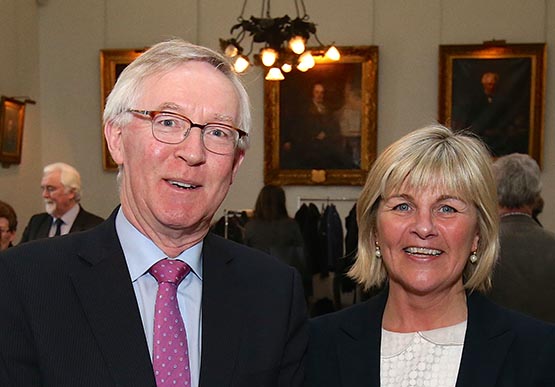
Dragons Den star Bobby Kerr – a sailing man himself – was the lively Master of Ceremonies
But in terms of being a setting which lends itself very positively to such a gathering, College Hall is right on target. It’s a splendid room which is confident with itself without being over the top. It comfortably accommodates the crowd of between 180 and 200 who have come from all over Ireland to celebrate what’s best in our sailing. And as if that weren’t enough, the RCSI has remarkable links with sailing going back more than a hundred years.
John Treacy, CEO of the Sports Council, with Liam Shanahan and ISA President David Lovegrove
So after last year’s first use of the venue, which stemmed from a typically far-sighted suggestion by ISA Board Member Brian Craig, people were keen to go back. And it wasn’t because no-one could think of anywhere better. On the contrary, it was because we’d found that the College of Surgeons is one of those wonderful buildings which make you feel better just from being in it. So in the early days of Spring when we wonder if summer is really going to come at all, a bit of a party in the College of Surgeons is just what the doctor ordered. And as for those doctors and surgeons from the RCSI going sailing, we’ll return to that at the end of this piece. But what of the event itself?
Well, with the Afloat.ie Sailor of the Year award going to a determinedly Corinthian skipper who cheerfully admitted that there’s any amount of professional sailors out there who could probably beat the pants off him, but nevertheless his core interest is offshore racing with family and friends, and if they win within those self-imposed limitations, then so much the better…..There it was, the real voice of Irish sailing, and no mistake.
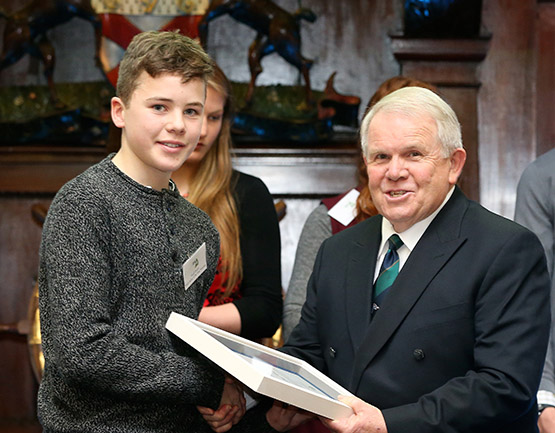
Pierce Purcell of Galway Bay SC with the RIYC’s Michael Boyd, Commodore of the Royal Ocean Racing Club
But what about the clubs through which we go sailing? How can they carry such a wealth of history, and yet be of any contemporary relevance? Here again, the evidence speaks for itself. The new Mitsubishi Motors Sailing Club of the Year has a wonderful history going back to 1831, yet in terms of sailing achievement and voluntary input into the local, regional and national organisation of sailing, it is making a fantastic contribution. And as for its relevance to sailing in the future, independently of the Club of the Year adjudication taking place, this same club was comfortably on its way to being the top ISA Training Establishment in its region, and on the shortlist for the national title too.
Olympian and rising stars – James Espey, Aoife Hopkins and Saskia Tidey
If that’s not an illustration of the way that Irish sailing honours its past while living in the present and looking to the future, then I don’t know what it is. But what’s this third point about Ireland being a cold place for professional sailing? Here again, the assembly in the RCSI was very representative of our Irish sailing population. For sure, there are some very distinguished Irish professional sailors, and there are certainly Irish owners who are prepared to pay the top talents to sail with them. But there’s something about the Irish sailing scene which is inimical to such a setup at home. By all means do it where the weather’s usually benign, and there’s lots of money floating around. But in the Irish climate you sometimes have to be so keen to go sailing despite hostile weather that you just have to rely on nutty amateur crew - the professionals know there’s much better and more reliable pickings elsewhere.
Thus we’ve come to the ironic situation that our top home-based professional sailors are actually our Olympic hopefuls. It’s extraordinary when you think that the modern Olympics were “re-founded” in 1896 in order to celebrate amateur sport, yet now in Ireland just about the only home-based sailors who can be said to be professional are the Olympic aspirants. And if they haven’t accepted that they need a professional approach, then they’re not really at the races at all.
Thus although the friendly Olympian presence of Annalise Murphy, James Espey and Saskia Tidey was much to be welcomed in the very representative throng, generally anyone who was there with any sort of a professional interest in sailing had it as part of a larger business in which actually going sailing is only a small part of the total setup.
Paralympic sailors Ian Costello and John Twomey
Admittedly we did have one Olympian who received an award, John Twomey who took the title in December for his qualification for the Paralympics in September 2016. And he came with added laurels, as on the very day of the ceremony, it had been announced that he and his crew of Ian Costello and Austin O’Carroll had moved up to fifth in the World Rankings. But if you suggested to John Twomey – headed for his 11th Olympiad – that he’s a professional sailor, he’d be convulsed in mirth. Real life is related to an accountancy practice in Kinsale.
So the only other monthly awardee who could remotely be said to be a professional sailor was August winner Ronan O Siochru. who skippered the winning Irish Offshore Sailing boat Desert Star to victory in the 33-strong Sailing Schools Division in the Rolex Fastnet Race 2015. But he’s very definitely running a business - and a very demanding one at that – in which going sailing is only part of it.
Ronan O Siochru with the President
Thus what Thursday’s ceremony was all about was voluntarism and amateur sport, and in case anybody missed the point, it was supposed to be a bit of fun. In this spirit, the greatest trophy in Irish sailing, the might salver for the Helmsman’s Championship, was given an outing. The All Ireland Helmsman’s Championship being an amateurs-only affair, as it is held over an October weekend, inevitably by the time its award ceremony for the salver is shaping up it’s well into Sunday evening. It’s getting dark, and everyone’s tired and wants to go home. So inevitably the handing-over of the historic trophy is a downbeat and somewhat rushed affair.
But as the ISA Annual Awards ceremony is all about handing over prizes with as much ceremony as possible, it was arranged for the salver – which had been hurriedly handed over to successful defender Anthony O’Leary in Dun Laoghaire back in October – to be smuggled out of the O’Leary household down in Crosshaven, secretly taken to Dublin, hidden away in the College of Surgeons, and then formally presented as a surprise extra to the great man after he’d received his Sailor of the Month award for April. He blushed.
Got him! Sailor of the Year 2014 Anthony O’Leary unavoidably missed last year’s awards ceremony, and then in 2015, although though he was Sailor of the Month for April, there were very few people around in October when he successfully defended the Helmsmans Championship Salver. So it was taken secretly to this week’s ceremony, where more than 180 people cheered him to the rafters.
ISA Youth Champions 2015 are Colin O’Sullivan and Doug Elmes, Bronze Medallists in the 420 Worlds.
Before all this, we’d been setting the scene with the ISA Youth Sailors of the Year, who were 420 Worlds Bronze Medallists Douglas Elmes and Colin O’Sullivan, and the ISA Training Centre of the Year, which was Mullingar Sailing Club from Westmeath which headed the Western Region, and overall came in ahead of Foynes YC from the Southern Region and the Royal Irish YC from the Eastern Region.
Katie Johnston of Mullingar Sailing Club with David Lovegrove when MSC was announced as ISA Training Centre 2015.
The new Mitsubishi Motors Sailing Club of the Year is the Royal Irish YC – Commodore James Horan with Billy Riordan of Mitsubishi Motors and David Lovegrove.
But for the RIYC Commodore James Horan, the good news was only beginning, as his club was then announced as the new Mitsubishi Motors Sailing Club of the Year for a host of excellent reasons. We’ll list them in more detail here on Afloat.ie in due course when the traditional handing-over ceremony for the old ship’s wheel trophy is held in the RIYC clubhouse later in the Spring. But meanwhile on Thursday we saw ample reason for it, as two of the Sailor of the Month awards went to very active RIYC members, George Sisk and Tim Goodbody.
July Sailor of the Month George Sisk with the ISA President
Dun Laoghaire Regatta Week 2015 Chairman, Fastnet Race 1987 overall winner, and multiple champion Tim Goodbody was Sailor of the Month in November
Youngest cruising award winner was Fergus Ogden, who in June and July sailed round Ireland with his brother in an open Drascombe Lugger.
Then came the Sailor of the Year announcement. Anyone who was following the voting in the Afloat.ie poll will know it was running very close. But as the poll results are only a quarter of the adjudication process, it was just a couple of days ahead of the awards ceremony when the judges finally made their decision. They came down in favour of Liam Shanahan both for his wonderful and very sporting victory in the Dun Laoghaire to Dingle Race with his family’s J/109 Ruth, and his subsequent success in retaining the Irish Sea Annual Championship title.
His modest acceptance speech was, in effect, a manifesto on behalf of all Irish amateur sailors, and particularly family sailors. The Shanahans are one remarkable sailing tribe right through three generations. And as for that win in the Dun Laoghaire to Dingle Race – well, it was beautiful sailing. Some sailing races are won by brutal slugging. Some are won by sheer cunning. Some inshore races are even won by dirty sailing, and it’s within the rules even if it does the image of our sport no good at all. But some race wins are simply beautiful sailing. And Ruth’s success in Dingle was definitely in that category.
After receiving his award, Liam Shanahan briefly but eloquently outlines his philosophy of sailing
So the ceremony on Thursday concluded with this celebration of the best in Irish sailing, and it chimed well with the mood of the moment and the location, as the current President of the RCSI is Declan Magee who sails from Dun Laoghaire, and he was most welcome at the party and naturally thanked for the use of the hall……
Then as we exited the College Hall, the first doorway we passed was the Sir Thomas Myles Room. He was RCSI President 1900-1902, a wonderful surgeon and a man of prodigious energy who boxed to championship level, and adored sailing. A Home Ruler of Limerick origins. he made his auxiliary ketch Chotah available to take the guns off Conor O’Brien’s Kelpie during the Asgard gun-running of 1914, and landed them in Kilcoole in County Wicklow. And though he was immediately made a Colonel and head of British army surgical services in Ireland on the outbreak of the Great War of 1914-18, he also saw to it that hidden rooms in the major Dublin hospitals under his control were available to treat wounded rebels, indeed anyone who was wounded, during the Rising of 1916.
Builders of the future – the team from Mullingar Sailing Club, ISA Training centre 2015
More recently, a leading sailing figure with links to sailing is Michael O’Rahilly who, when he became a student at RCSI at the end of the 2950s, found that the RCSI Sailing Club consisted of just one neglected Firefly dinghy. By the time he graduated in 1963, he was Club Captain, RCSISC had three Fireflies in top racing condition, and they were the Irish university champions.
Subsequently he went in to play a leading role in Dublin Bay SC, and was the Commodore for the DBSC Centenary in 1984. He follows in a notable RCSI tradition of sailing and working voluntarily for our sport, as an earlier top sailor in the college had been Jimmy Mooney who played a key role in the development of Irish dinghy sailing, and then went on to be our top Dragon sailor for many years, winning the Edinburgh Cup and representing Ireland in the Olympics.
Before Jimmy Mooney another noted character in the RCSI sailing scene was Rory O’Hanlon, who became a noted figure in offshore racing – he won a cup in the 1971 Fastnet Race – and was further renowned for his long distance cruising exploits.
He was noted as a kindly mentor to young cruising hopefuls, gently giving encouragement which could make all the difference to a nervous skipper. One such beginner, who later went on to great achievements, nervously went to Rory O’Hanlon to ask how best he should approach his first major voyage, north towards the Arctic in a little 26-footer.
“Sure, you just keep on sailing, and you’ll get there” said Rory. “Just keep on sailing, that’s all there is to it”. Just keep on sailing. It’s sensible advice. It resonated round College Hall in the RCSI on Thursday afternoon. We should all heed it.
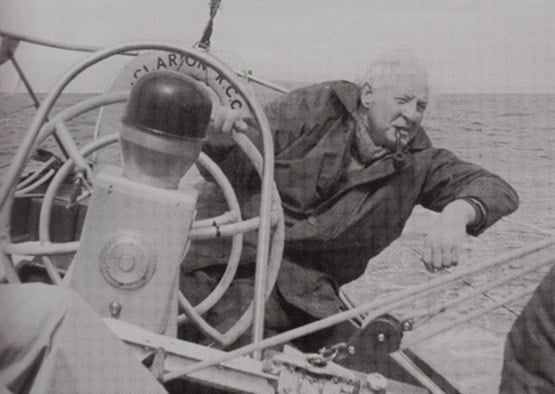
“Just keep on sailing, and you’ll get there”. The late Rory O’Hanlon at the helm of his S & S 43 Clarion with which he won the Philip Whitehead Cup in the 1971 Fastnet Race, and also cruised on long voyages. While a student at the Royal College of Surgeons in Ireland, he was active in the sailing club.
See also: Sailing Awards slideshow




























